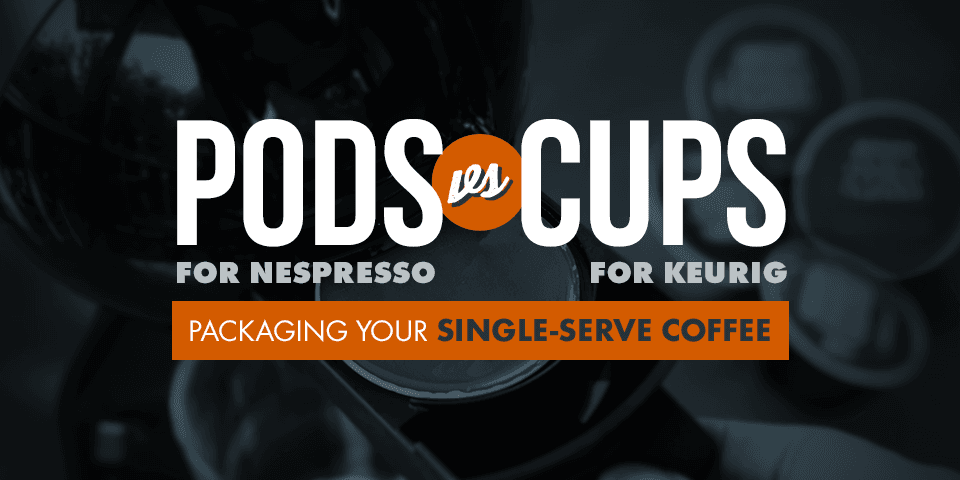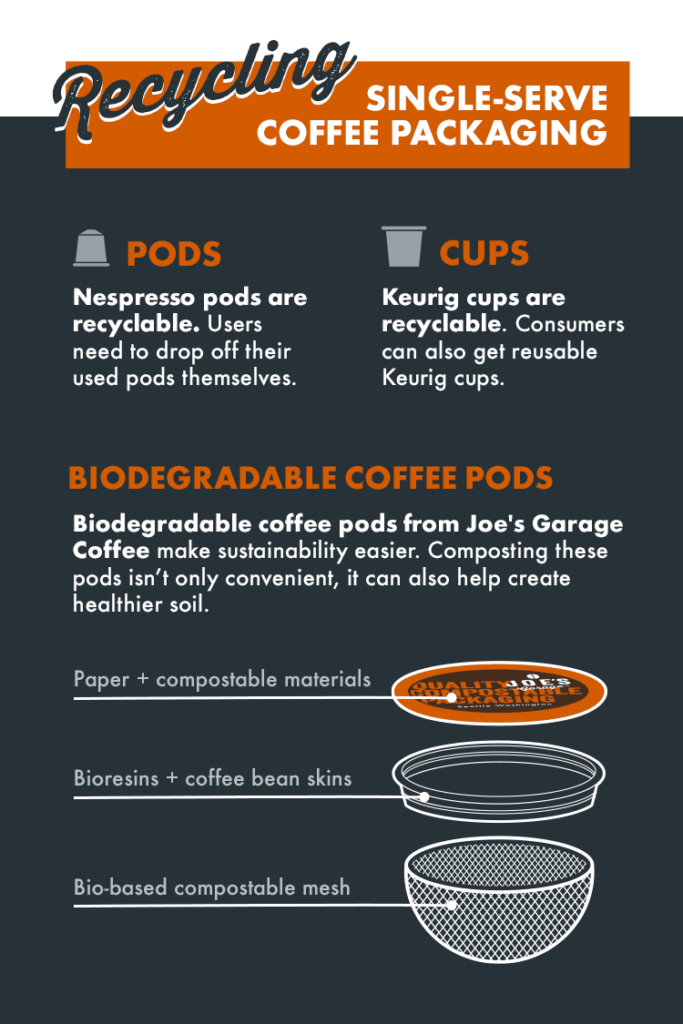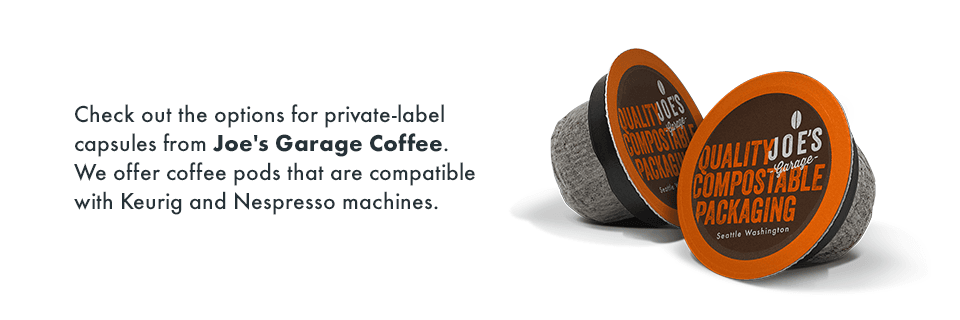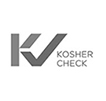Pods for Nespresso vs. Cups for Keurig: Packaging Your Single-Serve Coffee

Nespresso and Keurig have become famous for providing products that conveniently brew the perfect single serving of your favorite hot beverage. However, aside from this fundamental similarity, Nespresso and Keurig differ drastically from one another. Getting familiar with the particulars of Nespresso vs. Keurig will help coffee brand owners determine whether their product should go in a pod, a cup, or both.
You’ll discover the details of pods for Nespresso and cups for Keurig, along with valuable information about biodegradable coffee pods, soft paper-based coffee pods, and more. Keep reading to better understand the difference between Nespresso and Keurig and which one is right for your brand.
Overview of Nespresso Machines and Pods
In the late 1980s, Nespresso became the first brand to create coffee pods as a way of conveniently enjoying freshly brewed espresso at home. Now, Nespresso has expanded to offer two lines of espresso-focused machines — the Original and the Vertuo. The Original tends to be more popular in America because it offers high quality servings and provides more technologically advanced features.
Nespresso uses pods as its single-serving espresso packaging of choice. The company produces proprietary packages for different drink volumes, and there are currently no third-party competitors offering pod equivalents for the Nespresso Vertuo. The integrated barcode technology enables the machine to determine how long to brew each pod.
Once brewed, each Nespresso pod can produce a beverage that is as close to espresso as you can get without using a genuine espresso machine. In this way, using a Nespresso machine allows espresso aficionados to enjoy their favorite espresso beverage at home without having to purchase an expensive commercial-level espresso machine, sacrifice too much counter space, or measure out each espresso shot every time.
What Are Pods for Nespresso Made From?
Nespresso uses aluminum to construct its pods because it is the best material for protecting the espresso’s quality and freshness. Because aluminum is lightweight and durable, it is an excellent material for sealing the espresso from potentially harmful external elements, such as moisture, oxygen, and light.
Along with keeping the enclosed espresso fresh, aluminum offers the benefit of being infinitely recyclable, making it a sustainable choice for pod material. Thanks to aluminum pods, Nespresso can preserve its coffee’s carefully crafted aromas and rich flavors while still caring for the planet.
A Nespresso pod’s interior consists solely of ground coffee — no sugar, milk, or other additives. If you plan to add any sweetener or milk product to your espresso, you must do so after your beverage finishes brewing.
How Do Pods for Nespresso Work?
A Nespresso machine relies on a process known as centrifusion to brew its espresso. Each Nespresso pod has a flat top, making it easy for the machine to perform a series of multiple and strategic perforations into the pod. These perforations get the pod prepped for centrifusion.
During centrifusion, the coffee inside pods for Nespresso gets spun around to achieve the proper infusion of water needed to produce a seamlessly blended beverage. As the coffee spins, hot water gets pumped through the pod to brew the espresso. Toward the end of brewing, the machine pumps highly pressurized hot water through the pod to create the top layer of crema that is the signature of any authentic cup of espresso.
Following the centrifusion process allows a Nespresso machine to replicate a perfectly brewed shot of espresso as closely as possible.
Overview of Keurig Machines and Cups
While Keurig machines also produce a single-serve cup of coffee, they make a cup of drip coffee, not a shot of espresso. Keurig machines let users brew a fresh cup of regular drip coffee in seconds. Originally, Keurig marketed its products to offices, but the products’ convenient nature caused them to rapidly gain popularity for at-home use.
Though Keurig machines are available in a wide range of models, each Keurig uses cups as their brewing vessel. Keurig cups come in a vast array of blends, flavors, and varieties to suit any preference. Keurig partners with many brands to produce its cups, meaning consumers can get their favorite blend from Starbucks, Dunkin’, or another major coffee chain in a cup that’s compatible with their Keurig machine.
Keurig also offers the option of purchasing reusable filter cups, enabling users to turn their favorite brand of pre-ground or freshly ground coffee into a cup for their Keurig. In addition to coffee, Keurig cups are available in various tea and hot cocoa flavors. This seemingly endless array of options is one reason so many customers value their Keurig machine’s versatility.
What’s the Difference Between Keurig 1.0 and Keurig 2.0?
Initially, Keurig rolled out its 1.0 model as the first coffee machine suitable for convenient, single-serve, at-home brewing. The Keurig 1.0 is the classic coffee maker that doesn’t offer touchscreen capabilities but still brews a mean cup of joe. This Keurig model allowed consumers to use any cup they wanted, even those developed by a third party.
Then, Keurig released its 2.0 edition as a brand-new way of making your morning coffee. Keurig advertised the 2.0 as a technologically advanced single-serve coffee maker equipped with a new process of scanning cups. However, this innovative scanning process only worked for on-brand cups, locking out those made by unlicensed third parties.
Keurig 2.0’s incompatibility with third-party cups quickly made it the target of consumer backlash. As a result, Keurig swiftly discontinued the machines, reevaluated the model’s brewing methods, and re-released the 2.0 to be compatible with third-party cups.
Now, most Keurig models on the market are back to the original system of permitting consumers to use any cup they prefer. The revamped Keurig 2.0 also offers incredible new features like larger brews and impressive brew strength. In this way, the newer Keurig machines allow consumers to enjoy a greater variety of drink volumes and styles.
What Are Cups for Keurig Made From?
After the roasting process, Keurig coffee gets packed into tiny, airtight packages known as cups. During packaging, the products go through a special nitrogen flush to ensure there is minimal oxygen remaining in each cup, which protects the coffee from air, moisture, and light. Using nitrogen for preservation can keep the coffee’s taste fresh and unaffected by outside elements.
A Keurig cup’s base is a plastic container, which gets filled with coffee grounds. Along with the coffee itself, most Keurig cups contain a filter made from abaca fiber — the same material used for most tea bags. This filter gets welded to the sides of the container during the production process.
Once the cup has its internal filter and filled with coffee grounds, it gets a lid. A Keurig cup’s lid consists of food-grade aluminum foil that gets sealed to the cup in the filling and production process. After receiving its lid, the cup is ready for use in a Keurig machine.
How Do Cups for Keurig Work?
Because a Keurig cup already contains ground coffee and a filter, all that’s left is to add hot water for a perfectly brewed cup of coffee on the go. A Keurig machine accomplishes this by running hot water through the cup to brew the container’s contents.
More specifically, the Keurig machine starts by puncturing a hole in the cup’s aluminum foil lid. Another hole gets punched through the bottom of the cup so the beverage can flow directly into the mug waiting below. Then, the machine sends hot water down through the ground coffee, while pushing it through the filter in the cup. The beverage lands in your mug, giving the user a delicious, fresh brew to kickstart their day.
Are Keurig Cups Recyclable?
As of recently, Keurig cups are 100% recyclable. Previously, the plastics in these cups made it challenging to recycle them. However, manufacturers have transitioned to using a plastic that communities throughout the continent widely accept for curbside recycling.
Along with using single-brew recyclable Keurig cups, consumers can purchase reusable Keurig cups. These act more like Keurig-compatible refillable filters than single-use cups. Switching to reusable Keurig cups enables daily coffee drinkers to cut down on waste and customize their morning beverages.
Are Nespresso Pods Recyclable?
Since Nespresso pods are aluminum, they are recyclable. Though aluminum is infinitely recyclable, Nespresso users must recycle the pods themselves because Nespresso follows a specific recycling process that includes a refined process for breaking down and repurposing used pods.
Here are the scheme’s fundamental steps.
- Used pods go to the recycling facility.
- Shredding the pods separates the aluminum capsule from the coffee grounds.
- The coffee grounds get transformed into nutrient-rich compost or green energy.
- The aluminum gets melted away from the plastic coating and other materials.
- The remaining pure aluminum gets recycled to become car engines, computers, bicycles, soda cans, etc.
Though Nespresso users must drop off their used pods themselves, Nespresso makes this process relatively easy and convenient. In addition to providing hundreds of thousands of collection facilities worldwide, Nespresso partners with local courier and postal services to make recycling used pods simple.
What Are Biodegradable Coffee Pods Made From?
A step up from recyclable coffee pods are biodegradable coffee pods. Biodegradable coffee pods made by third parties like Joe’s Garage Coffee naturally compost, thanks to their eco-friendly materials. While standard coffee pods and cups are not compostable, biodegradable coffee pods consist of materials that readily break down into organic matter by microbes and biological factors.
Being compostable means that biodegradable coffee pods can disintegrate naturally once returned to the ground. After consumers brew with a biodegradable coffee pod, they can be composted through commercial facilities instead of having to take additional steps to ensure the pod gets recycled.
Biodegradable coffee pods from Joe’s Garage Coffee make sustainability easier. This added convenience makes many consumers prefer biodegradable coffee pods to typical coffee pods or cups. As a bonus, composting biodegradable coffee pods can even help create healthier soil.
Biodegradable coffee pods are excellent for composting because each component’s materials leave a minimal environmental impact. Here’s a breakdown of each piece.
- The lid: Paper, compostable ink, and other compostable materials make the lid perfect for the compost pile.
- The filter: The pod’s mesh portion is a bio-based substance that composts well.
- The ring: Blending bioresins from coffee bean skins and renewable resources produces the pod’s compostable ring.

Coffee Capsules vs. One Cup Filter Pods
Another popular single-serve coffee container option is soft, paper-based one cup filter pods. While coffee capsules like pods for Nespresso and cups for Keurig are solid, cylindrical packed containers, soft one cup filter pods have a wider diameter and are flimsy, like a flattened tea bag.
Many consumers like using soft one cup filter pods because they significantly reduce waste, and most brands decompose naturally. Soft one cup filter pods are also excellent because they work with virtually any coffee machine. These characteristics make soft one cup filter pods suitable for anyone with a single-serve coffee machine who’s looking for easily disposable pods.
On the other hand, many consumers prefer to stick with the more traditional cylindrical coffee capsules because they’re more familiar and dependable. While soft one cup filter pods tend to be fragile and often require extra storage measures for preservation, standard coffee pods can remain in storage for an extended period and still maintain their freshness. Conventional coffee capsules are also more aesthetically pleasing.
Coffee Capsules vs. Instant Coffee
Coffee capsules are full of coffee grounds, which is distinctly different from instant coffee. Instant coffee is a beverage derived from already roasted coffee beans. To make instant coffee, the roasted coffee beans are typically freeze-dried or spray-dried, creating a dry substance that can rehydrate to become liquid coffee.
Also known as coffee powder, instant coffee allows consumers to quickly prepare hot coffee by stirring the powder with hot water. Though instant coffee can churn out a mug of java faster than brewing a coffee capsule in a Keurig or a Nespresso, instant coffee sacrifices some quality for speed.
Instant coffee is generally bitterer than other types of coffee and has an overall less satisfying taste. Because the drying and freezing processes used to make instant coffee take away some of the coffee’s aroma, instant coffee is less flavorful. On the other hand, coffee capsules offer the full flavor and aroma of freshly ground coffee, provided you’re willing to wait an extra minute or two.
Should Your Brand Use Coffee Capsules?
Now that you’re familiar with the different kinds of coffee capsules and all they have to offer consumers, it’s time to decide whether coffee capsules are right for your brand. With so many people opting for single-serve coffee makers these days, your business can reach a broader audience by offering coffee capsules.
In addition to making your brand compatible with more coffeemakers, offering coffee capsules for Nespresso or Keurig machines can help you appeal to more coffee fanatics across the globe. Due to the numerous advantages pods and cups offer coffee consumers, supplying these compact coffee containers can help your brand reach its target market more effectively.
Choose coffee capsules if your target audience is interested in the following perks.
- Convenience: Coffee pods and cups can help your customers save far more time in the morning than regular bags of coffee.
- Consistency: Coffee capsules pack a consistent, dependable taste in each pod.
- Simplicity: If your customer base is looking for an easy, foolproof way of brewing a single cup of coffee in the morning, coffee capsules are the solution.
- Freshness: Coffee capsules’ individual packaging keeps the coffee fresher than bagged coffee.
- Variety: Customers who like to mix up their morning brew will love the variety of flavors and styles that coffee capsules have to offer in a convenient single-serve format.
- Sustainability: Anyone interested in going green will appreciate biodegradable coffee pods and the recyclability of regular pods and cups.
Learn About Our Private-Label Capsules Compatible With Keurig and Nespresso Machines
If you’re interested in selling coffee capsules, check out the wide array of options for private-label capsules from Joe’s Garage Coffee. We offer coffee pods that are compatible with Keurig and Nespresso machines, so you’ll have no problem finding a choice that complements your brand.
Related Content








